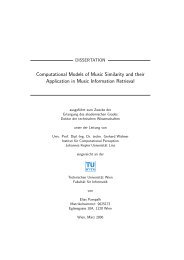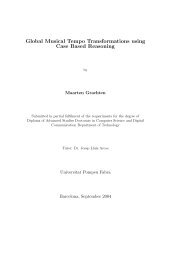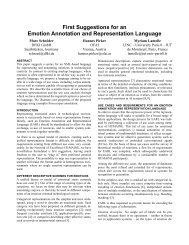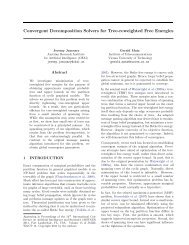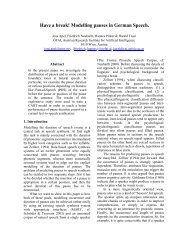A HYBRID MODEL OF REASONING BY ANALOGY
A HYBRID MODEL OF REASONING BY ANALOGY
A HYBRID MODEL OF REASONING BY ANALOGY
You also want an ePaper? Increase the reach of your titles
YUMPU automatically turns print PDFs into web optimized ePapers that Google loves.
3) In AMBR a mechanism similar to ACME (Holyoak & Thagard, 1989b) is used which is a form<br />
of relaxation search in a connectionist network. In the case of AMBR where objects have<br />
corresponding descriptions (in contrast to ACME where objects are semantically empty) this<br />
mechanism makes it possible to establish the correspondences between objects and relations in<br />
parallel.<br />
There is a number of differences between the constraint networks in AMBR and in ACME. First,<br />
in contrast to ACME, in AMBR this is not a separate network but is an temporary built extension<br />
of the LTM of the reasoner. Consequently, the state of the reasoner's mind (the presently active<br />
elements of LTM and the relations between them) will influence the relaxation search. Second, in<br />
contrast to ACME, prior to relaxing the network, in the phase of its construction, it is possible to<br />
establish some correspondences (between objects or relations) when they are highly relevant and<br />
semantically similar. This will restrict the space of possible mappings described by the network.<br />
This makes it possible to model both cases: a) internal domain or close domain analogies where<br />
usually object similarity plays a major role and b) abstract analogies between far domains where<br />
usually higher-order relations dominate the mapping.<br />
Cognitive architecture<br />
GENERAL DISCUSSION<br />
Continuousness vs. Discreteness Dualism: A Hybrid Approach<br />
A hybrid cognitive architecture is proposed which combines the advantages of a symbolic approach<br />
(used for complex structured representation of situations, problems, plans, concepts, etc. as well<br />
as for the benefits of a marker passing mechanism in specialized search tasks) with the strength of<br />
connectionism in associative retrieval and soft constraint satisfaction.<br />
These different approaches are highly integrated. It is not the case that each part of the system is<br />
organized according to one of these approaches (communicating with the other parts). On the<br />
contrary, it is rather the case that different processes (symbolic and connectionist) work on the<br />
same structures which are considered as frames by the symbolic processes while the connectionist<br />
mechanisms consider them simply as nodes and links. This is possible because of the specific,<br />
rather distributed frame organization. Although there is a single frame representing a given object<br />
or concept, a lot of frames have to be traversed in order to extract all information about it, i.e. there<br />
is a whole network of frames describing an object. This is due to the fact that there is no local<br />
information in the frames but only references (pointers) to other frames. The same links are used<br />
both for spreading activation and for marker passing, but the two processes are not independent:<br />
the possibility for, and the speed of marker passing strongly depend on the activation of the nodes.<br />
In this way the connectionist aspect of the architecture continuously "restructures" the knowledge<br />
base of the reasoner represented by the symbolic aspect thus controlling the set of possible<br />
inferences at any moment. It makes some nodes more accessible and others inaccessible, thereby<br />
assigning priorities, restricting the search, etc. This makes the knowledge base dynamic and<br />
context-dependent.<br />
There is actually a dual representation of the current situation:<br />
a) an implicit distributed representation - the distribution of activity in the whole network (LTM)<br />
according to the associative relevance of each memory element, and<br />
b) an explicit local representation - a structured symbolic representation of the situation including<br />
its most important elements and the relations between them.<br />
In this way symbolism and connectionism are considered as dual aspects of human cognition




